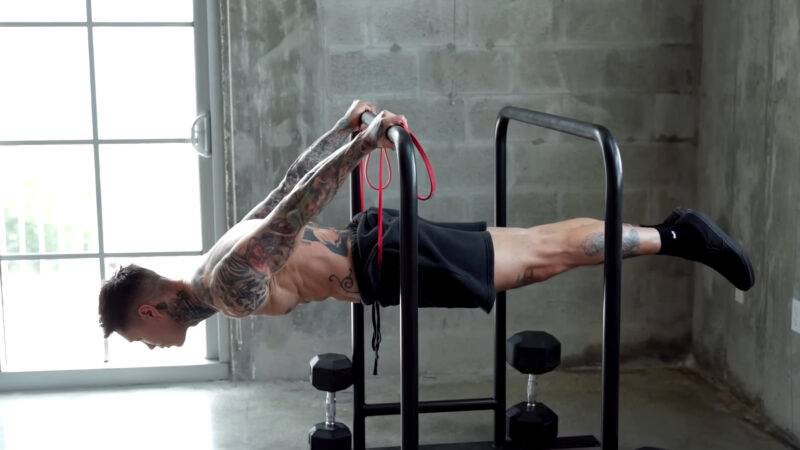Resistance band back exercises are a great alternative to using free weights, especially if you want to workout at home. Using natural, controlled force to work the muscles in the back and hips, resistance bands can increase flexibility, stability, and the overall strength of the lower back muscles, which means less pain, a stronger back, and a happier you!
Resistance bands might not look like much, but they can strengthen your muscles as effectively as more traditional weights.
You should work slowly, and think about the movement you are doing. It is very important to concentrate on the contractions, not only when you pull (positive), but also when the pull goes back to the starting position (negative).
There are many alternative exercises for the back, as well as those where the back is the secondary muscle to be contracted. However, I decided to present you with 4 exercises where the back is the primary muscle to be contracted. With each of these back techniques, you can freely and safely work at your place.
4. Resistance band rows
My list of top 4 Resistance band back exercises starts with Resistance band rows. It is a great exercise to build strength and lean muscle in your back. It’s much more efficient because, unlike picking up dumbbells or barbells and working against gravity, the band’s resistance strengthens the back muscles. People with lower back issues can also do resistance band rows.
- Begin in a seated position on the floor with legs straight out in front of you.
- Holding handles, place the center of the band around the feet, then wrap each end inside and around each foot one more time to make a loop on each foot.
- Sit tall with abs tight and hold handles in front of you with elbows bent next to your side.
- Pull the handles back until they are next to your side and elbows are behind you. Slowly release.
3. Bent over Rows with resistance bands
The bent-over row primarily works the latissimus dorsi (the large wing-like muscles in your back), the middle and lower trapezius, the rhomboids, and the posterior deltoids. These are the prime movers that are responsible for the movement in the exercise. Before you begin, make sure you hold the proper form:
- Stand with both feet in the middle of the resistance band.
- Hinge from your hip, bend your knees and keep your weight centered. You don’t want your heels to be rocking.
- Keep your back flat and arms straight.
- Wrap your hands around the band.
- Bend your elbows to pull the band up, and keep your elbows towards your back.
- Slowly straighten your arms and lower your hands back to the starting position.
The bent-over row primarily works the latissimus dorsi (the large wing-like muscles in your back), the middle and lower trapezius, the rhomboids, and the posterior deltoids. These are the prime movers that are responsible for the movement in the exercise.
2. Face Pulls with a Resistance Band
Face Pulls primarily work the rear deltoids (shoulders), rhomboids and the external rotators (infraspinatus and teres minor). Keeping these muscles strong and conditioned is extremely important. Especially for those who do a lot of pressing-type exercises like push-ups, bench press, and overhead press.
What’s more, the pulling nature of the exercise puts far less strain on your shoulder joints, meaning you can work harder and for longer without running the risk of injury.
1. Resistance Band Lat Pulldown
The lat pulldown is one of my top picks when it comes to back exercises using resistance bands. Let’s go over how to do this exercise correctly to work those lats.
- First, find a spot above you where you can secure the resistance band. If you’re using an Undersun door anchor, you’ll need to place it over the top of the door. Close the door and thread the band through the loop on the door.
- Next, kneel on the floor. This will allow you to stretch the bands more, giving you better resistance throughout the exercise.
- Now, pull down all the way, imagining that you’re squeezing your back. This will ensure a full range of motion and a good contraction at the top.
Do 20 reps on the first set, making sure they’re challenging. Then, increase the resistance for sets two and three, doing 10 reps each. Finally, go back to the original resistance for set four and do 15 reps.
And there you have it, the lat pulldown using resistance bands to help you build a broader back.
Summary
Resistance band back exercises might not seem like much, but they’re actually super effective at strengthening your muscles, just like traditional weights. By using natural and controlled force, you can work the muscles in your back and hips, improving flexibility, stability, and overall strength in your lower back.
This means less pain and a happier you! Just remember to take it slow and focus on the movements you’re doing. It’s important to concentrate on the contractions, both when you’re pulling and when you’re releasing back to the starting position. We went over some great exercises like resistance band rows, bent-over rows, face pulls, and the lat pulldown. All of these exercises target different muscles in your back, helping you build strength and lean muscle.
Plus, they’re great for people with lower back issues. So, give these exercises a try and see how resistance bands can help you build a stronger and healthier back!

